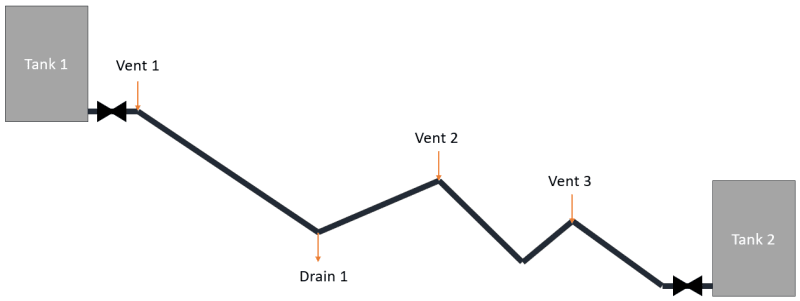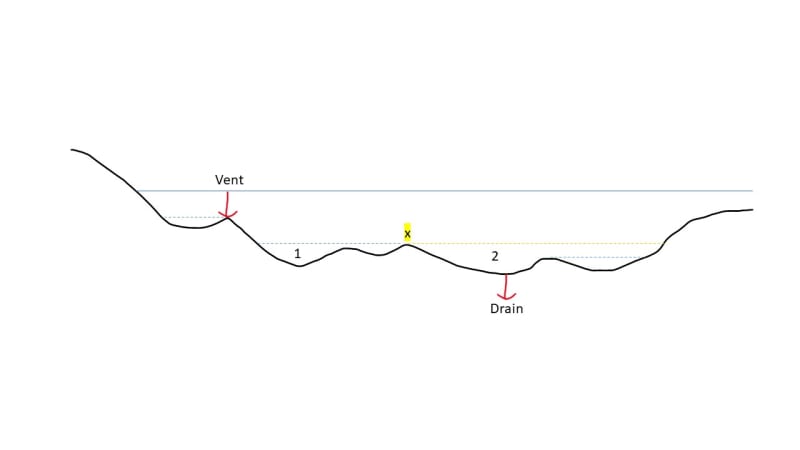Dear All,
I am reaching out once again with a question and would greatly appreciate your valuable insights, as you have consistently provided in the past. Kindly refer to the accompanying sketch for context.
Situation:
I am currently dealing with an isolated pipeline that is being emptied via Drain 1. The pipeline is equipped with 3 vents, all of which are in the open position. The maximum drainage rate achievable is 300 m3/h. Consequently, it is imperative to ensure an equal airflow into the pipeline to prevent the occurrence of under-pressure.
Initial Consideration:
My initial contemplation led me to allocate a vent capacity of 100 m3/h to each of the three vents (Vent 1, Vent 2, and Vent 3). However, upon closer examination, Vent 3 appears to have no contribution due to its lower positioning. Consequently, it appears necessary to appropriately design Vent 1 and Vent 2, both with a capacity of 150 m3/h each.
Query:
In an effort to streamline my evaluation process, considering the numerous drains and vents involved along the pipline, I need you advice on the potential impacts of adopting the following approach when calculating vent capacity for air intake:
Q_intake = Q_max_drainage / n
where "n" represents the total number of drains. Applying this formula to the aforementioned scenario, would the resulting air intake capacity (for Vent 1, Vent 2, and Vent 3) indeed be 100 m3/h (?)
Clarification:
Imagine if the drainage process were to pull water from the lower section of the pipeline (since the air intake of Vent 1 and Vent 2 are only 200 m3/h together. Would this potentially activate Vent 3 at some point, especially if the capacities of Vent 1 and Vent 2 are insufficient? Or is it more likely that the drainage flow would just stay limited to a total of 200 m3/h without any significant problems / damage to the pipeline (steel pipe)?
Thank you in advance for your inputs!
Cheers,
Jack

I am reaching out once again with a question and would greatly appreciate your valuable insights, as you have consistently provided in the past. Kindly refer to the accompanying sketch for context.
Situation:
I am currently dealing with an isolated pipeline that is being emptied via Drain 1. The pipeline is equipped with 3 vents, all of which are in the open position. The maximum drainage rate achievable is 300 m3/h. Consequently, it is imperative to ensure an equal airflow into the pipeline to prevent the occurrence of under-pressure.
Initial Consideration:
My initial contemplation led me to allocate a vent capacity of 100 m3/h to each of the three vents (Vent 1, Vent 2, and Vent 3). However, upon closer examination, Vent 3 appears to have no contribution due to its lower positioning. Consequently, it appears necessary to appropriately design Vent 1 and Vent 2, both with a capacity of 150 m3/h each.
Query:
In an effort to streamline my evaluation process, considering the numerous drains and vents involved along the pipline, I need you advice on the potential impacts of adopting the following approach when calculating vent capacity for air intake:
Q_intake = Q_max_drainage / n
where "n" represents the total number of drains. Applying this formula to the aforementioned scenario, would the resulting air intake capacity (for Vent 1, Vent 2, and Vent 3) indeed be 100 m3/h (?)
Clarification:
Imagine if the drainage process were to pull water from the lower section of the pipeline (since the air intake of Vent 1 and Vent 2 are only 200 m3/h together. Would this potentially activate Vent 3 at some point, especially if the capacities of Vent 1 and Vent 2 are insufficient? Or is it more likely that the drainage flow would just stay limited to a total of 200 m3/h without any significant problems / damage to the pipeline (steel pipe)?
Thank you in advance for your inputs!
Cheers,
Jack


